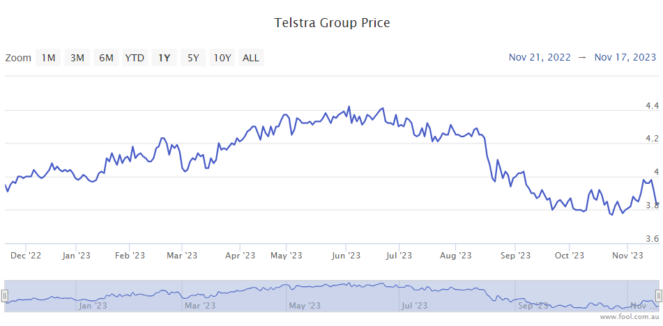The Telstra Group Ltd (ASX: TLS) share price has been drifting lower over the last few months. Over the past half-year, it has fallen 12%, as we can see on the chart below.

The ASX telco share has significantly underperformed the S&P/ASX 200 Index (ASX: XJO) over that same time period – in the past six months, the ASX 200 has only dropped by 2.8%.
After the recent weakness, could Telstra shares rebound to $4 by Christmas? Firstly, let me remind investors that we shouldn't focus much on a short-term timeframe like a month.
But, it could be good to evaluate how the business is going and where a broker is suggesting that Telstra shares could go from here.
Outlook
Telstra recently held its 2023 investor day, with a number of updates.
One of the most important things from the day was the company reaffirmed its guidance for FY24.
It said that total income is expected to come in a range of between $22.8 billion to $24.8 billion, compared to FY23's figure of $23.2 billion.
Underlying earnings before interest, tax, depreciation and amortisation (EBITDA) is expected to be between $8.2 billion to $8.4 billion in FY24, up between 2.5% to 5% compared to FY23's $8 billion.
Free cash flow after lease payments is predicted to be between $2.8 billion to $3.2 billion, which compares to $2.8 billion in FY23. Profit and cash flow are key influencers on Telstra shares.
Telstra's key division is the mobile business, which the company said is well-positioned for long-term growth.
It says that there are at least three strong demand drivers. First, the Australian population is expected to grow between 1% to 2% per annum between 2023 to 2027. Second, mobile data demand continues to grow strongly. Third, there is a significant increase in new products, services and devices that are connected to the internet in some way.
The business has recently been increasing prices in line with the CPI inflation number, which is providing an organic boost for revenue and earnings.
Telstra said that it's benefiting from operating leverage with its mobile infrastructure, with more subscribers using the same telecommunications infrastructure with "ongoing cost discipline".
The company has an ambition to reduce its net fixed core reduction costs by $500 million between FY23 to FY25, while still investing for growth.
Areas of productivity include migrating customers off legacy platforms, delivering efficiency in IT software costs, decommissioning legacy infrastructure and seeing further benefits from AI, automation and digitisation.
Where to next for Telstra shares?
The broker UBS is positive on the company – it has a buy rating and a price target of $4.55 on Telstra. A price target is a forecast of where the share price might be in 12 months from here. But it's just a guess.
The $4.55 price target implies a possible rise of 19.4% over the next 12 months. So, the price target is positive and it suggests Telstra shares could rise from here, if the broker is correct.
UBS thinks that, while the cost reduction target may be difficult, the revenue growth can help profit growth and enable the dividend per share to grow from an estimated 18 cents per share in FY24 to 23 cents per share in FY26.
Those numbers imply that owners of Telstra shares could get a grossed-up dividend yield of 6.75% in FY24 and 8.6% in FY26.








